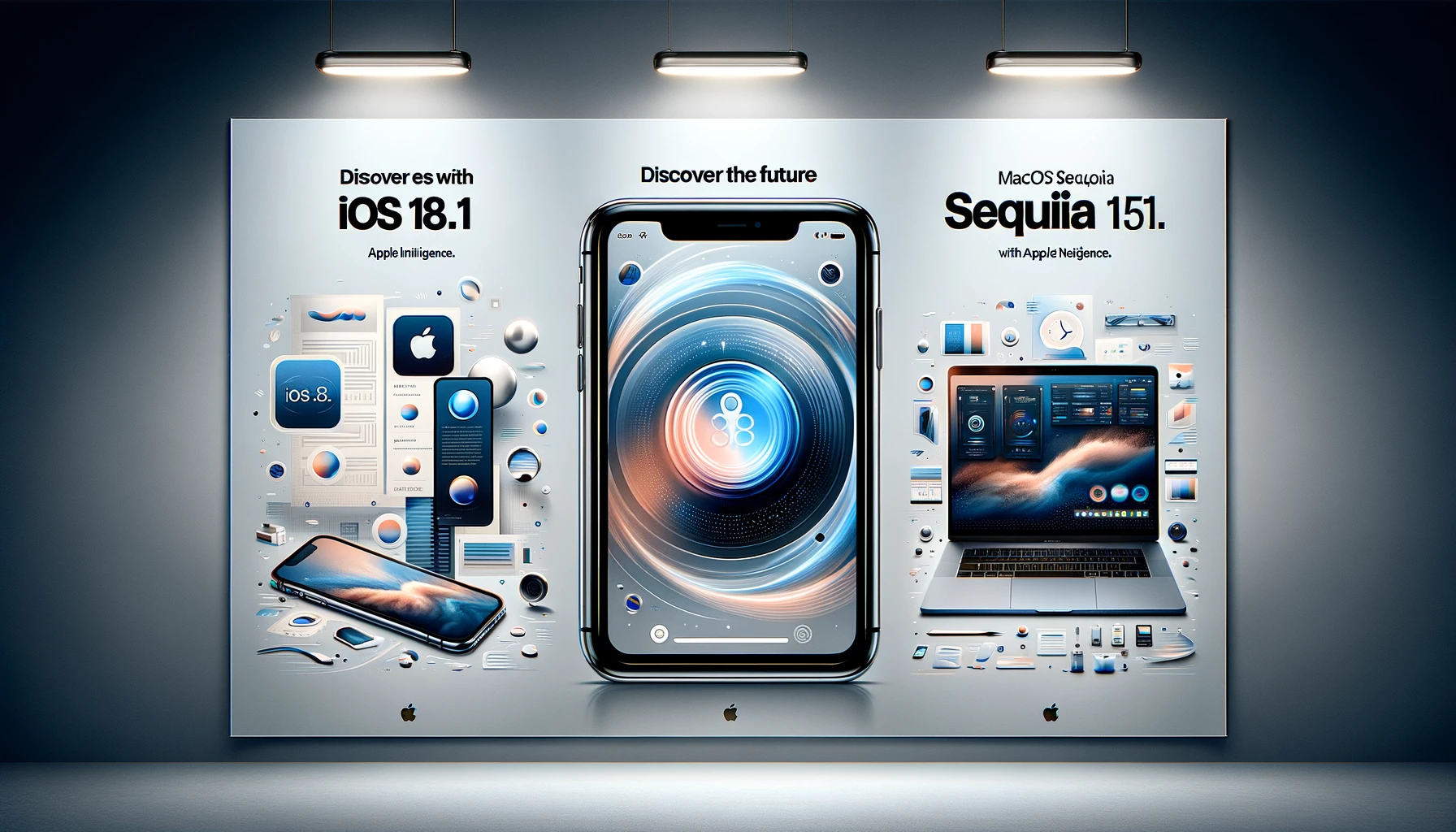iOS 18.1, iPadOS 18.1, and macOS Sequoia 15.1: New Features, Release Dates, and How They Compare to Previous Versions
Apple’s latest software updates—iOS 18.1, iPadOS 18.1, and macOS Sequoia 15.1—are generating significant buzz in the tech community. These updates, bolstered by the introduction of Apple Intelligence, promise to enhance user experience across all devices. In this blog, we will delve into the new features, explore the anticipated release dates, and compare these updates to previous versions. Whether you are an Apple enthusiast or a casual user, understanding these updates will help you make informed decisions about upgrading your devices.
iOS 18.1 Apple Intelligence Features: What’s New?
One of the most exciting aspects of iOS 18.1 is the integration of Apple Intelligence. This AI-powered enhancement brings several new features designed to make iOS devices smarter and more intuitive.
Key Features Introduced by Apple Intelligence
- Advanced Siri Improvements: Apple Intelligence has significantly improved Siri, making it more responsive and contextually aware. Siri can now understand and execute complex commands more efficiently, thanks to deeper integration with apps and better natural language processing. These Apple Intelligence Siri improvements are set to make Siri more useful in daily tasks, from setting reminders to controlling smart home devices.
- Enhanced Focus Modes: iPadOS 18.1 Focus Modes have been revamped to allow for more customization and automation. Users can now set different Focus Modes for different times of day, activities, or locations, and Apple Intelligence can suggest Focus Modes based on user behavior. This feature helps in minimizing distractions and improving productivity by automatically filtering notifications and apps based on the user’s current activity.
- Phone Call Recording: One of the most requested features, iOS 18.1 phone call recording, has finally been introduced. This feature allows users to record calls directly through the iOS interface, with options to store and manage recordings within the Phone app. This can be particularly useful for business professionals or anyone who needs to keep a record of important conversations.
These features reflect Apple’s commitment to enhancing user experience through AI, making iOS 18.1 Apple Intelligence features some of the most anticipated in recent updates.
macOS Sequoia 15.1 New Features: A Closer Look
macOS Sequoia 15.1 is the latest update in Apple’s line of macOS operating systems, and it comes with a host of new features aimed at improving performance, security, and user experience.
Significant Enhancements in macOS Sequoia 15.1
- Improved Multitasking and Window Management: macOS Sequoia 15.1 introduces new window management tools that make multitasking easier and more intuitive. Users can now create custom workspaces with different window configurations that can be saved and recalled instantly. This feature is particularly useful for professionals who work on multiple projects simultaneously.
- Refined Security Features: With the rise in cybersecurity threats, Apple has doubled down on security in macOS Sequoia 15.1. The update includes advanced encryption protocols and improved privacy settings, ensuring that user data is protected more robustly than ever before.
- Better Integration with Apple Intelligence: Like iOS 18.1, macOS Sequoia 15.1 benefits from Apple Intelligence, particularly in areas like search and app recommendations. The system can now predict user needs based on past behavior, offering suggestions for apps, documents, and actions before the user even asks.
- New Interface Design: A subtle yet impactful change in macOS Sequoia 15.1 new features is the updated user interface, which offers a cleaner, more modern look. The design changes are consistent across Apple’s ecosystem, ensuring a seamless experience whether you’re on a Mac, iPad, or iPhone.
These enhancements make macOS Sequoia 15.1 not only a powerful update but also a necessary one for users looking to stay secure and productive in a digital world.
iOS 18.1 vs iOS 18: What’s Different?
With the release of iOS 18.1, many users are wondering how it compares to its predecessor, iOS 18. While the updates may seem incremental, there are several key differences worth noting.
Major Differences Between iOS 18.1 and iOS 18
- Performance Improvements: iOS 18.1 vs iOS 18 shows significant performance upgrades. The latest version is optimized for newer devices, providing faster load times and smoother multitasking. These improvements are particularly noticeable on older devices that struggled with iOS 18.
- Bug Fixes and Stability: iOS 18.1 addresses several bugs and stability issues that were present in iOS 18. This includes fixes for battery drain problems and issues with certain apps crashing. Users can expect a more stable and reliable experience with the update.
- New Features and Functionality: While iOS 18 laid the groundwork, iOS 18.1 builds on it with the introduction of Apple Intelligence and other new features. The enhanced Focus Modes, phone call recording, and improved Siri functionality are just a few of the additions that make iOS 18.1 a substantial upgrade.
For users on the fence about upgrading, the iOS 18.1 vs iOS 18 comparison highlights the tangible benefits of moving to the latest version, especially in terms of performance and new features.
iPadOS 18.1 Beta Access: How to Get Started
For those eager to try out the latest features before the official release, iPadOS 18.1 beta access provides an opportunity to explore what’s new while contributing to the development process.
Steps to Access the iPadOS 18.1 Beta
- Enroll in Apple’s Beta Software Program: To gain iPadOS 18.1 beta access, users must first enroll in Apple’s Beta Software Program. This can be done by visiting the Apple Beta Software Program website and signing in with your Apple ID. Once enrolled, you’ll be able to download and install the beta version directly on your device.
- Backup Your Device: Before installing the beta, it’s crucial to back up your device. Beta versions are typically less stable than official releases, and backing up ensures that you can restore your device if something goes wrong.
- Install the Beta Profile: After enrolling, you’ll need to download the beta profile from the Apple Beta Software Program website. Once the profile is installed, your device will be able to receive beta updates over the air, just like regular iOS updates.
- Provide Feedback: As a beta user, you’ll have the opportunity to provide feedback directly to Apple. This feedback is invaluable in helping Apple identify bugs and make improvements before the final release.
Participating in the iPadOS 18.1 beta access program allows users to experience new features early while also playing a role in shaping the final product.
macOS Sequoia 15.1 vs Ventura: Which Should You Choose?
Apple’s decision to release macOS Sequoia 15.1 following the success of Ventura has led many users to wonder how the two compare. Both versions offer robust features, but they cater to slightly different needs.
Comparing macOS Sequoia 15.1 and Ventura
- Performance Enhancements: macOS Sequoia 15.1 vs Ventura reveals that Sequoia 15.1 is optimized for newer Mac models, offering better performance and efficiency. Ventura, while still powerful, may not run as smoothly on the latest hardware, making Sequoia 15.1 the better choice for those with the latest Macs.
- Feature Set: Sequoia 15.1 introduces several new features that are absent in Ventura, such as enhanced multitasking tools and better integration with Apple Intelligence. These features make Sequoia 15.1 a more attractive option for users who rely heavily on their Macs for work or creative projects.
- Security and Privacy: Sequoia 15.1 also comes with updated security protocols, making it a more secure option for users concerned about privacy. While Ventura remains secure, the newer features in Sequoia 15.1 provide an added layer of protection.
- User Interface: The updated interface in Sequoia 15.1 offers a more modern and streamlined look compared to Ventura. This visual refresh is consistent with the design language across Apple’s ecosystem, providing a more unified experience.
For users deciding between macOS Sequoia 15.1 vs Ventura, Sequoia 15.1 offers a more comprehensive set of features, better performance on new hardware, and enhanced security, making it the superior choice for most users.
Apple Intelligence Waitlist: How to Join
The introduction of Apple Intelligence in iOS 18.1, iPadOS 18.1, and macOS Sequoia 15.1 has generated significant interest, leading to a waitlist for some of its more advanced features.
Joining the Apple Intelligence Waitlist
- Sign Up Through Apple’s Website: Users interested in joining the Apple Intelligence waitlist can do so by visiting Apple’s official website. There, you’ll find a section dedicated to Apple Intelligence, where you can sign up to be notified when features become available to the public.
- Eligibility Requirements: While Apple Intelligence is available to all users in a basic form, some advanced features may be limited to those on the waitlist. Eligibility is typically based on your device model and Apple ID status.
- Receiving Updates: Once on the waitlist, you’ll receive regular updates from Apple about the availability of new features and how to access them. Being onOnce on the waitlist, you’ll receive regular updates from Apple about the availability of new features and how to access them. Being on the Apple Intelligence waitlist also means you might get early access to some of the most anticipated features, allowing you to explore new functionalities before they are widely released.
For those eager to stay ahead of the curve, joining the Apple Intelligence waitlist is a smart move. It ensures you’re among the first to experience the cutting-edge AI features that Apple is rolling out across its ecosystem.
What These Updates Mean for You
The release of iOS 18.1, iPadOS 18.1, and macOS Sequoia 15.1 marks a significant step forward in Apple’s software ecosystem. With enhancements powered by Apple Intelligence, these updates are designed to offer users a more intuitive, secure, and efficient experience. Whether you’re excited about the new Apple Intelligence Siri improvements, looking to join the Apple Intelligence waitlist, or debating between macOS Sequoia 15.1 vs Ventura, these updates have something to offer everyone.
As always, staying updated with the latest software is crucial for maximizing the performance and security of your devices. Whether you’re a casual user or a professional, understanding the differences between iOS 18.1 vs iOS 18, and the features introduced in iPadOS 18.1 and macOS Sequoia 15.1, will help you make informed decisions about upgrading.
This guide is intended to provide a comprehensive overview of Apple’s latest software releases, helping you navigate the new features, improvements, and changes that come with iOS 18.1, iPadOS 18.1, and macOS Sequoia 15.1. As you explore these updates, keep in mind the benefits of staying current with Apple’s software, ensuring you get the most out of your devices in terms of functionality, security, and user experience.




